TIMELINE OF THE HUN EMPIRE + THE HUNGARIAN EMPIRE + THE SCYTHIAN EMPIRE + SOME HISTORY ON KHAZAR EMPIRE & THE SUMERIAN EMPIRE & THE AVAR-HUN EMPIRE
Click for Source Article by HUNGARIAN HISTORICAL CHRONOLOGY
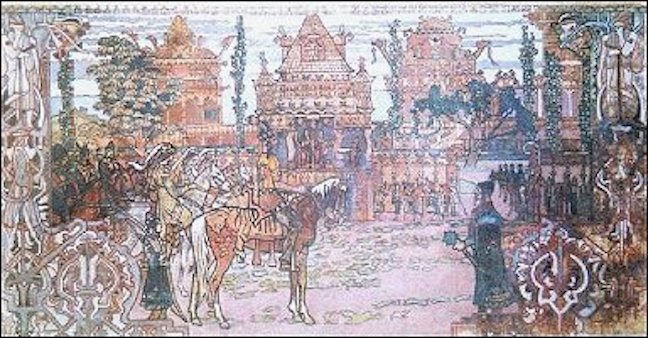
ATTILA THE HUN PALACE
ONLY TWO NON-HISTORIC and/or BIBLICAL REFERENCES:
BIBLE: GENESIS 10, 8-13: Cush was the father of Nimrod, who began to show himself a man of might on earth. ‘Like Nimrod, a mighty hunter before the Lord’. His kingdom in the beginning consisted of Babel, Erech, and Accad, all of them in the land of Shinar/Sumer in Meopotamia. From that land he migrated to Asshur and built Nineveh, Rehoboth-Ir, Calah, and Resen, a great city between Nineveh and Calah.’
MYTHOLOGY – ORIGINS AND EARLY HISTORY of Hungarians, who call themselves Magyar, have an ancient traditional pre-christian account of their origins according to which they were the descendents of Nimrod, son of Cush; Nimrod and Eneth had two sons, Magor and Hunor; Magor was the ancestor of the Magyars, and Hunor was the ancestor of the Huns, thus symbolizing the common origins of the Huns and of the Magyars. Byzantine sources mention that the Magyars were also known as the Sabirs who originated from Northern Mesopotamia. Numerous other ancient and medieval sources also refer to the Scythians, Huns, Avars and Magyars as identical peoples. Scholarly research has confirmed the Sumerian-Scythian-Hun-Avar-Magyar scientific and scholarly research all concur with the Hungarians’s own ancient account of their origins.
10000 BCE-8000 BCE The Neolithic revolution: the invention of agriculture and animal domestication in the ancient Near East, the “Fertile Crescent” – the region between the Eastern Mediterranean and the Zagros mountains of Western Iran – by the peoples who formed the distinct (non-Semitic and non-Indo-European) ethno-linguistic group from which the Sumerians, the creators of the first civilization, originated.
5500 BCE Beginning of the Copper Age: Mesopotamia becomes the culturally dominant region of the Near East: first Northern Mesopotamia (Subir-ki/Subartu), and from 4500 BCE, Southern Mesopotamia, the land of Sumer. Due to the demographic and economic growth resulting from the Neolithic revolution, the Near Eastern population begins to expand, settling in the Mediterranean and Danubian basins, Eastern Europe, Iran, India, and Central Asia, laying the foundations of civilization in those regions and exerting a determining cultural influence upon the later formation of the various Eurasian ethno-linguistic groups.
5000 BCE THE SETTLEMENT OF THE CARPATHIAN BASIN — The first of several waves of Near Eastern settlers appear in the Carpathian Basin, the territory of Historical Hungary. The archeological, anthropological, ethno-linguistic and historical evidence indicates that the Carpathian Basin was settled in successive waves from approximately 5000 BCE by the Neolithic, Copper and Bronze Age peoples originating from Anatolia, Transcaucasia and Mesopotamia, followed by the Turanian peoples of Central Eurasia: the Scythians (600 BCE), the Huns (400s AD), the Avars (500s AD), the Magyars (800s AD), the Petchenegs (1000s AD), the Cumans (1200s AD), and Khazar Empire (450 AD-800 AD). These Turanian peoples originated from the same ancient Near-Eastern ethno-linguistic group as the Neolithic, Copper and Bronze Age settlers of the Carpathian Basin. The Hungarians are therefore the descendants of these Turanian peoples and of the original settlers of the Carpathian Basin.
3200 BCE SUMER – Beginning of the Bronze Age: Height of the Sumerian civilization; development of numerous cultural and technological inventions (writing, the wheel). First Sumerian Empire extends from the Eastern Mediterranean to Western Iran, including all of Mesopotamia.
3000 BCE-2000 BCE Sumerian colonies are established from the Atlantic Ocean through the Mediterranean and Danubian basins to India and Central Asia (Turan), and from the Caucasus to Northeast Africa. The vast belt of Eurasian grasslands stretching from the Carpathian mountains to the Altay range, bordered in the North by the Eurasian forest belt and in the South by the Caucasus and the Iranian plateau, is gradually settled by Sumerians and Sumerian-related peoples from Mesopotamia, Transcaucasia and Iran. These Near Eastern settlers of the Eurasian grasslands became the peoples which were later referred to as the Scythians, Huns, Avars and Magyars among others, and collectively known as the Turanians. The Turanians were therefore the descendents of the Sumerian-Mesopotamian peoples, and the inheritors of this ancient Near Eastern culture. The Turanian peoples had a profound cultural impact on their Celtic, Germanic, Slavic, Finnic, Siberian and East Asian neighbours, which have preserved numerous Turanian ethno-linguistic and cultural elements.
3000 BCE – 2455 BCE First appearance of nomadic Semitic tribes in Sumerian Mesopotamia. Semitic peoples begin to settle in increasing numbers in Mesopotamia. The Sumerian civilization exerts a dominant influence upon the development of later Semitic cultures.
2455 BCE – 2356 BCE The Semitic Accadians impose their hegemony upon the Sumerian city-states. Mesopotamia is devastated by wars, the population is decimated, oppressed and enslaved by the Accadians. Many Sumerians flee to their colonies.
2356 BCE – 1900 BCE The Sumerian city-states and their allies overthrow the Semitic Accadian hegemony, liberating themselves from foreign oppression.
1900 BCE – 1733 BCE The Semitic Babylonians impose their hegemony upon Mesopotamia.
1733 BCE – 1163 BCE The Kassites, one of the Sumerian-related peoples inhabiting Western Iran, overthrow the Semitic Babylonian hegemony and establish their rule over Northern Mesopotamia. A Sumerian dynasty rules over Southern Mesopotamia from 1860 BC to 1492 BC.
1115 BCE – 612 BCE The Semitic Assyrians impose their hegemony over the Near East after centuries of warfare. The ensuing devastation, decimation, deportations and oppression alter the ethnic composition of the Near East, including Mesopotamia, as the Semitic element increases and the Sumerians decrease.
612 BCE THE SCYTHIAN EMPIRE – The Sumerian-related Chaldeans, Medes and Scythians annihilate the Assyrian Empire. The Scythians dominate the vast Eurasian grasslands from the Carpathian Basin to the Altay during centuries. Altay is a city in Kazakh, in Easter Europe with Turkic peoples near Ural mountains, and has 142,000 inhabitants.
600 BCE-300 BCE SCYTHIAN DOMAINS included gold clothing ornament, Kul Oba Kurgan, Crimea
539 BCE-331 BCE After overthrowing the Median Empire, the Persians conquer Mesopotamia and the rest of the Near East.
256 BCE-226 AD After the fall of Persia, the Parthian Empire rules over Mesopotamia, Armenia and Iran. The Turanian Parthians, custodians of the ancient Sumerian civilization, resist the Eastern expansion of the Roman Empire. In 226 AD, the Persian Sassanids overthrow the Parthian Empire which experiences a revival between 272 AD and 326 AD.
200 BCE THE HUN EMPIRE – The Hun Empire reaches its greatest extent from the Pacific to the Aral sea, from Siberia to the Parthian Empire and China. The Huns face centuries of struggle against an increasingly offensive and encroaching Chinese imperialism and expansionism.
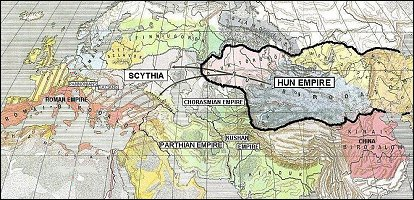
200 AD THE EARLY HUN EMPIRE OF EAST THAT BROKE THROUGH THE GREAT WALL OF CHINA
200 BCE The Huns break through the Great Wall of China
200 AD-400 AD Facing mounting pressures from China in the East, the Huns begin to expand into Europe. The Huns begin their Western military campaigns.
375 AD the Huns defeat the Goths, triggering fear in Germanic Tribes & the great migration of Germanic tribes which also contributed to the collapse of the Roman Empire. The unstoppable Hun charge terrified the peoples of what is now norther Europe. The pope pleads for mercy as Atilla stands victorious at the gates of Rome.
400 AD-500 AD The Huns continue their crushing military campaigns against the Roman Empire. The Huns expel the Romans from the Carpathian Basin (North of Danube River — Pannonia and Dacia where the Romans had perpetrated genocidal warfare against the indigenous inhabitants) & and the Hun Empire establishes its centre of power in the Carpathian-Danubian region.
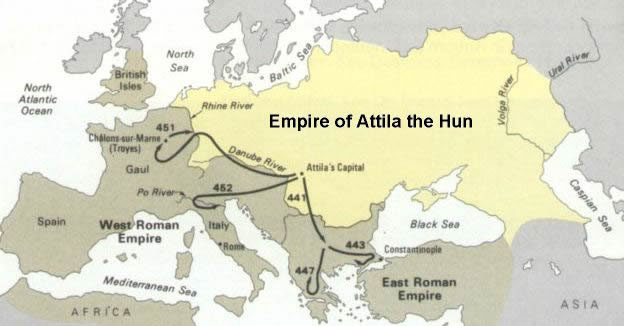
ATTILA THE HUM EMPIRE
453 AD THE WESTERN HUN EMPIRE covered all of Northern Europe. Following Atilla’s death under suspicious circumstances, the Huns’ Germanic allies turn against them and the bulk of the Hunnic tribes regroup to the East of the Carpathians, leaving a rear-guard tribe in the Eastern Carpathians.
453 AD-TODAY This Hunnic tribe still inhabits this region today and they are the Hungarian Székely people. Of course, the Khazar Empire followed after the decline of the Huns.
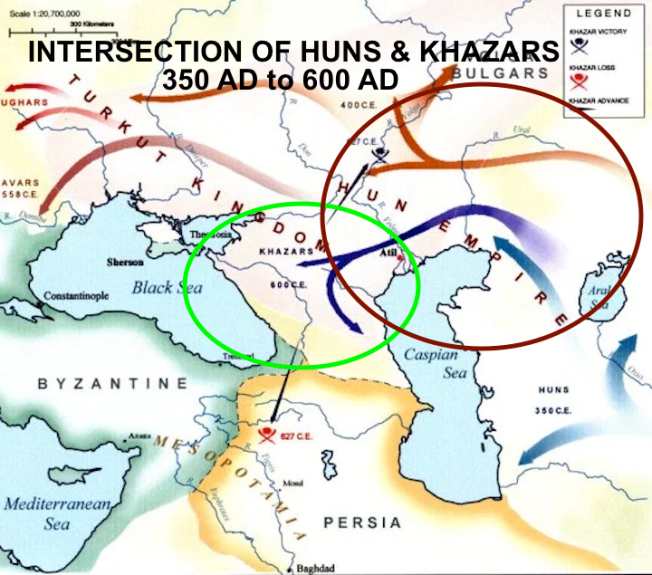
528 AD The Byzantine attempt to convert the Huns to the Christian religion, but fail after the Huns rebel against the destruction of their ancient religious symbols.
562 AD THE AVARS – The Avar-Huns establish their empire in Central and Eastern Europe, with the Carpathian Basin as the centre of power. The Avars continue their centuries-long struggle against the encroaching German and Byzantine empires.
700 AD AVAR GOLD TREASURE of Sânnicolau Mare or Nagyszentmiklós found in 1799 in the Kingdom of Hungary – the treasure was transferred to Vienna, the capital of the empire.

THE HUNGARIAN EMPIRE
997 AD THE MAGYARS — Following the reign of the Hungarian ruler Géza, during which foreign interests gain increasing influence under the guise of Christianization, Géza’s son István (Stephen) is installed as king of Hungary with the assistance of foreign armed intervention, in violation of ancient Hungarian traditions and of the sacred Covenant of Blood. Koppány, the rightful heir to the throne and leader of the national resistance is captured and quartered. Under the rule of István, feudalism and Christianity are imposed by force. The ancient Hungarian runic scriptures are burned and the traditionalist leaders and priests persecuted and exterminated.
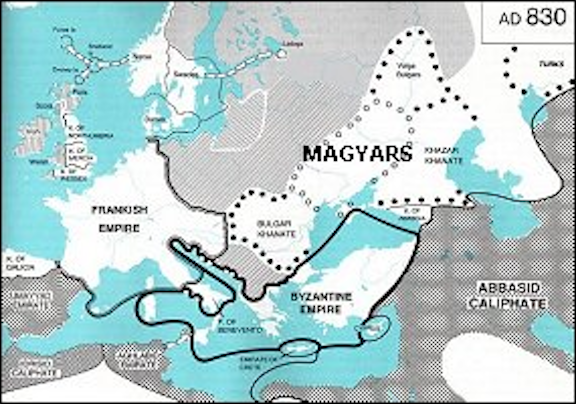
830 AD The early Hungarian Empire & The Magyars Empire
800 AD Following the settlement of a small number of Spanish Jewish refugees in the Khazar Empire, the ruling dynasty of the Khazars, another Turanian people, is converted to Judaism and seeks to impose this religion upon all its subjects. This precipitates a civil war. Several rebel Khazar tribes join the Hungarian tribal federation which was led by the Magyar tribe. At that time the Hungarians were established in their own independent state of Dentumagyaria led by Álmos, between the Avar and Khazar empires.
895 AD-896 AD After the collapse of the Khazar Empire, the Magyars and the other Hungarian tribes move West into the Etelköz region, where the Covenant of Blood takes place. This Covenant effectively creates the Magyar (Hungarian) nation which proceeds with the reconquest of the Carpathian Basin and its surrounding regions. After expelling foreign encroaching powers from the Carpathian region and uniting with their previously settled Hun-Avar ethnic kin, the Magyars establish the Hungarian State in 896 as the successor state to the Hun and Avar empires. Árpád is chosen as the leader of the Hungarians.
907 AD Following Hungarians victory over the invading German tribes in 907, they launch a series of military campaigns in Europe to prevent the formation of a large powerful united empire in the West that would threaten the Hungarian State & also to recover the Avar gold treasures pillaged by the invading Germans during the previous century.
997 AD Following the reign of the Hungarian ruler Géza, during which foreign interests gain increasing influence under the guise of Christianization, Géza’s son István (Stephen) is installed as king of Hungary with the assistance of foreign armed intervention, in violation of ancient Hungarian traditions and of the sacred Covenant of Blood. Koppány, the rightful heir to the throne and leader of the national resistance is captured and quartered. Under the rule of István, feudalism and Christianity are imposed by force. The ancient Hungarian runic scriptures are burned and the traditionalist leaders and priests persecuted and exterminated. The Westernization of Hungary results in the enslavement of the Hungarian population under an increasingly foreign feudal ruling class and church where foreign influences and foreign interests become predominant.
997 AD-1526 AD MEDIEVAL HUNGARY: With the exception of a few periods of relative peace and prosperity under the reign of Hungarian kings, medieval Hungary was characterized by an almost continuous political instability due to the constant struggle for power between various ruling factions. “Pagan” and “peasant” rebellions demonstrated the Hungarian people’s resentment against the foreign Christian feudal regime. Hungary was increasingly forced into the sacrificial role of “Easternmost bastion of Western Christianity”, which caused incalculable losses to the Hungarian nation as it was maneuvered by foreign interests into conflicts with the Mongols (1200s AD) and the Turks (13oos AD- 1600s AD). The execution of rebel Hungarian peasants by the feudal rulers included torture and execution. The Petcheneg tribal leader Tonuzoba was buried alive with his wife and horse as a result of his refusal to convert to Christianity.
1526 AD-1699 AD HUNGARY UNDER HABSBURG RULE was partitioned – As a result of the previous centuries of feudal regime, a weakened and internally divided Hungary was unable to withstand external pressures. The foreign-influenced ruling feudal class failed to defend the national interests and this led to the 1526 military defeat at Mohács against the Ottoman army and to the subsequent partition of Hungary. Thus, Hungary was occupied and partitioned by the Habsburgs and the Ottomans, with the Principality of Transylvania remaining as an autonomous entity. These events proved to be catastrophic for the future historical development of Hungary as the Hungarian population suffered great losses due to centuries of warfare and foreign occupation.
1701 AD-1711 AD After the Ottoman Empire’s withdrawal, the Austrian Habsburg take-over of Hungary was met with Hungarian resistance in the 1701-11 War of Independence, but Hungary remained under Habsburg control. Hungary thus became an oppressed, exploited and colonized land as a result of which the Hungarian nation became politically, economically, socially, culturally and demographically marginalized in its own country.
1701 AD-1711 AD Prince Ferenc Rákóczi, leader of the Hungarian War of Independence & Hungarian Freedom Fighters, were part of the Hungarian War of Independence
1848 AD-1849 AD Another Hungarian War of Independence took place, which was defeated with Russian intervention. However, Austria was unable to obstruct the Hungarian national will to reassert its historical rights later.
1867 AD The Austro-Hungarian Compromise took place, granting Hungary domestic self-rule, but the ministries of finance, foreign affairs and war remained under Habsburg imperial control. As the Habsburgs continued their policy of divide and rule, they incited the foreign ethnic groups settled in Hungary against the Hungarians, and this policy led to the First World War.
1918 AD-1944 AD Trianon Hungary – After the armistice ending WWI, a liberal government took over in Hungary as the country was occupied by enemy forces, paving the way for a Communist coup carried out by mostly non-Hungarians in 1919. This led to the territorial dismemberment of Hungary at the Treaty of Trianon in 1920, whereby Hungary lost nearly 3/4 of its territory and millions of Hungarians were forced under the oppressive foreign rule of the neighboring states newly created and enlarged at Hungary’s expense. The treaties ending WWI were responsible for WWII, and once again, Hungary was forced to participate in a war against its will. Between 1938 and 1941, Hungary recovered some of its lost territories. Hungary entered the war following an unprovoked attack by foreign (supposedly Soviet) forces in 1940. After attempting peace negotiations with the Allies, Hungary was invaded by the Nazis in 1944, and later that same year by the Soviets.
1944 AD-1990 AD Hungary under Soviet occupation – At the Paris Treaty of 1947, the Trianon borders of 1920 are reimposed upon Hungary. In 1948, a Communist regime is imposed in Hungary. Once again, the hard-core of the Hungarian Communist Party is formed by non-Hungarians imported from the Soviet Union. In 1956 the Hungarian National Uprising against the Soviet Communist regime takes place but is crushed by yet another Soviet military intervention. The Hungarian Communist regime continues its anti-Hungarian policies aiming to destroy Hungarian national consciousness and traditional cultural values. In the 1980’s the Hungarian Communist regime was financed by huge loans from Western financial institutions.
1990 AD-Today THE “POST-COMMUNIST” ERA – After decades of totalitarian dictatorship, the Hungarian Communist party successfully consolidated and entrenched itself, and was able to stage what appeared to be a peaceful transition to a freely elected democratic political regime. However, the Communists Jews remain in control of all the key positions in the state apparatus, including the media, the legal system and the academic institutions, and in the newly expanding private sector of the economy. As a result, the marginalization and exclusion of Hungarian national interests continues to this day. Hungary is still burdened by the increasing foreign debt for which the Communist regime was responsible. The privatization of Hungarian State assets by the former Communist elite in collaboration with foreign corporate interests has been fraudulent and has resulted in the illegal acquisition of most of Hungary’s economy by foreign interests with the intentional exclusion of Hungarian ownership. Hungary has been pressured to sign disadvantageous treaties with several neighboring countries whereby, in exchange for the Hungarian recognition of the current state borders and the renunciation of any future territorial claim, the neighboring countries in question promise to respect the rights of the Hungarian ethnic populations living under their rule. However, far from respecting these treaties, Hungary’s neighbors continue to implement their policies of anti-Hungarian discrimination and ethnic cleansing which they have pursued since 1920. As a result of these trends and policies, the entire Hungarian nation is facing threats to its existence on multiple fronts, politically, economically, socially, culturally, and demographically. Realizing the seriousness of this situation, various movements and political parties have begun to mobilize and lobby for the protection of the Hungarian national interests.
div{float:left;margin-right:10px;}
div.wpmrec2x div.u > div:nth-child(3n){margin-right:0px;}
]]>
Source Article from https://concisepolitics.com/2017/11/09/timeline-of-the-hun-empire-the-hungarian-empire-the-scythian-empire-some-history-on-khazar-empire-the-sumerian-empire-the-avar-hun-empire/
 RSS Feed
RSS Feed















 November 9th, 2017
November 9th, 2017  Awake Goy
Awake Goy  Posted in
Posted in  Tags:
Tags: 













